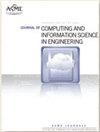A Flexible and Accurate Additive Manufacturing Data Retrieval Method based on Probabilistic Modeling and Transformation-Invariant Feature Learning
IF 2.6
3区 工程技术
Q2 COMPUTER SCIENCE, INTERDISCIPLINARY APPLICATIONS
Journal of Computing and Information Science in Engineering
Pub Date : 2024-04-17
DOI:10.1115/1.4065344
引用次数: 0
Abstract
Additive manufacturing (AM) is gaining prominence across numerous fields, which involves the generation of extensive data at each process stage. A relational database is a useful tool to store such AM data in a key-value manner and streamline data retrieval. Users can specify the value of one AM variable or key and retrieve the corresponding record values of another key. This establishes the correlations between AM variables, and supports applications such as process planning. Nonetheless, such an operation is a “hard” query, which lacks reasoning capabilities and fails to provide useful information when required records are missing. It is urgent to develop a more powerful AM database to handle AM data better, which should support “soft” queries, be scalable to high-dimensional data, and maintain flexible query functionality among multiple keys. In this paper, we upgrade an AM database with probabilistic modeling and transformation-invariant feature learning, which is termed as a probabilistic AM database (PAMDB). The PAMDB allows the selection of any key as a query key, or even multiple keys as query keys, to retrieve the values of other keys, which is adapted to unseen, high-dimensional, and multi-modal AM data. Two case studies were conducted for laser powder bed fusion (LPBF) and vat photopolymerization (VP). Compared with existing methods, experimental results underscore the efficacy of the PAMDBs, both qualitatively and quantitatively, in tasks that includes melt pool size prediction and scan parameter estimation in LPBF, and defect detection for the resin deposition process in VP.基于概率建模和变换不变特征学习的灵活准确的增材制造数据检索方法
快速成型制造(AM)在众多领域日益突出,这涉及在每个流程阶段生成大量数据。关系数据库是以键值方式存储此类 AM 数据并简化数据检索的有用工具。用户可以指定一个 AM 变量或键的值,并检索另一个键的相应记录值。这可以建立 AM 变量之间的相关性,并支持流程规划等应用。然而,这种操作属于 "硬 "查询,缺乏推理能力,在缺少所需记录时无法提供有用信息。当务之急是开发功能更强大的 AM 数据库,以更好地处理 AM 数据,该数据库应支持 "软 "查询,可扩展至高维数据,并在多个键之间保持灵活的查询功能。在本文中,我们升级了一种具有概率建模和变换不变特征学习功能的 AM 数据库,并将其称为概率 AM 数据库(PAMDB)。PAMDB 允许选择任何键作为查询键,甚至多个键作为查询键,以检索其他键的值,这适应于未见、高维和多模态 AM 数据。针对激光粉末床熔融(LPBF)和大桶光聚合(VP)进行了两个案例研究。与现有方法相比,实验结果凸显了 PAMDB 在定性和定量方面的功效,包括 LPBF 中熔池尺寸预测和扫描参数估计,以及 VP 中树脂沉积过程的缺陷检测。
本文章由计算机程序翻译,如有差异,请以英文原文为准。
求助全文
约1分钟内获得全文
求助全文
来源期刊
CiteScore
6.30
自引率
12.90%
发文量
100
审稿时长
6 months
期刊介绍:
The ASME Journal of Computing and Information Science in Engineering (JCISE) publishes articles related to Algorithms, Computational Methods, Computing Infrastructure, Computer-Interpretable Representations, Human-Computer Interfaces, Information Science, and/or System Architectures that aim to improve some aspect of product and system lifecycle (e.g., design, manufacturing, operation, maintenance, disposal, recycling etc.). Applications considered in JCISE manuscripts should be relevant to the mechanical engineering discipline. Papers can be focused on fundamental research leading to new methods, or adaptation of existing methods for new applications.
Scope: Advanced Computing Infrastructure; Artificial Intelligence; Big Data and Analytics; Collaborative Design; Computer Aided Design; Computer Aided Engineering; Computer Aided Manufacturing; Computational Foundations for Additive Manufacturing; Computational Foundations for Engineering Optimization; Computational Geometry; Computational Metrology; Computational Synthesis; Conceptual Design; Cybermanufacturing; Cyber Physical Security for Factories; Cyber Physical System Design and Operation; Data-Driven Engineering Applications; Engineering Informatics; Geometric Reasoning; GPU Computing for Design and Manufacturing; Human Computer Interfaces/Interactions; Industrial Internet of Things; Knowledge Engineering; Information Management; Inverse Methods for Engineering Applications; Machine Learning for Engineering Applications; Manufacturing Planning; Manufacturing Automation; Model-based Systems Engineering; Multiphysics Modeling and Simulation; Multiscale Modeling and Simulation; Multidisciplinary Optimization; Physics-Based Simulations; Process Modeling for Engineering Applications; Qualification, Verification and Validation of Computational Models; Symbolic Computing for Engineering Applications; Tolerance Modeling; Topology and Shape Optimization; Virtual and Augmented Reality Environments; Virtual Prototyping
文献相关原料
| 公司名称 | 产品信息 | 采购帮参考价格 |
|---|

 求助内容:
求助内容: 应助结果提醒方式:
应助结果提醒方式:


